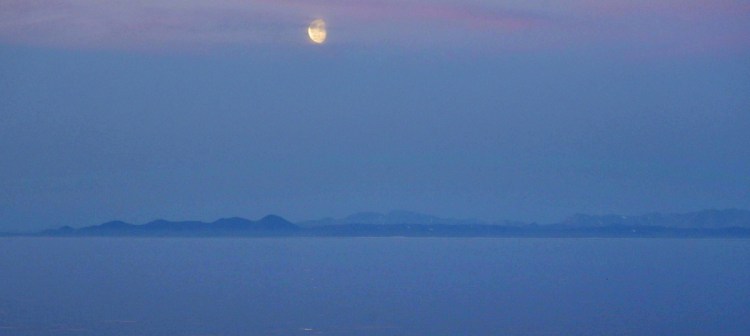LONDON — Under partly sunny skies and relatively balmy temperatures in the low 50s, the Venta Maersk sailed through the Bering Strait this past week and steered hard to port, beginning a modern-day voyage of discovery that could hearken a transformation for global shipping and the Arctic environment.
The Venta is a big, new, pricey, ice-class vessel owned by Danish shipping giant Maersk – and it is the world’s first container ship to attempt the Northern Sea Route, the fabled Northeast Passage that runs from the edge of Alaska to the top of Scandinavia along Russia’s desolate Siberian coastline.
Maritime transit is now possible between July and October because of the rapid and, to many, deeply unsettling retreat of Arctic sea ice because of profound climate change, a trend that is amplified at the North and South poles.
Russia, China and commercial shipping interests are among those with high hopes that the Northern Sea Route could become a melt-season alternative to Egypt’s Suez Canal, trim weeks off transit times and slash fuel costs for vessels shuttling between ports in Europe and Asia – and the Americas.
The Russian company Rosatom, which runs the largest nuclear-powered ice-breaking fleet in the world, boasts that the route has “no queues and no pirates,” an allusion to the threat posed by African buccaneers in the Gulf of Aden in recent years.
But as the pace of Arctic traffic quickens, an environment that is today mostly pristine and sparsely populated – by whales and walruses, scientists and indigenous people, ice-breaking crews and oil workers – could be transformed.
And Russia and its competitors may find themselves at odds over who controls what and where. “The Arctic has turned into an object of territorial, resource and military-strategic interest for a number of states,” Russian Defense Minister Sergei Shoigu warned last month. “This could lead to growth in the potential for conflict in this region.”
Decades ago, the polar cap was a Cold War chessboard for dueling navies and submarine war games. The next fight will be more mercantile.
Time-lapse satellite images show sea ice swirling in clockwise gyre around the North Pole, spreading in the winter and shrinking in the summer, year after year. It is plainly discernible that the extent of summer ice has been shrinking – by 13.4 percent a decade, according to NASA.
Looking forward, Walt Meier, a senior research scientist at the National Snow and Ice Data Center in Colorado, said climate models suggest ice-free summers in the Arctic sometime between 2050 and 2070, with some scenarios forecasting more rapid change, as soon as 2030.
What would that look like from a satellite?
“A blue ocean over the North Pole in September,” Meier said.
That’s extremely distressing for the many who worry about the future of life on this planet. But this “new Arctic” could be a boon for some, starting with Russia.
The Northern Sea Route, because of its location along the shallow seas of Siberia, is free of ice earlier and stays free longer than other areas of the Arctic. Much of the route passes through waters along Russia’s exclusive economic zone, and vessels seeking passage must apply for permits and permissions from Russia’s Northern Sea Route Administration. The Russians also charge fees for navigation and ice-breaking assistance.
It can be a perilous passage.
“If you get into trouble, you are very far from civilization,” said Mika Hovilainen, a senior project manager at Aker Arctic Technology, which designs ships with hardened propulsion systems and thick bows to withstand the battering of floating sea ice.
He called conditions in the Arctic, even in summer, “extreme.”
But the route’s key selling point is time. A ship sailing from South Korea to Germany via South Africa’s Cape of Good Hope would take on average 46 days, according to searoutes.com. The same voyage via the Suez Canal would be 34 days. The trip via the Northern Sea Route: 23 days.
Hundreds of smaller ships are already out there. A few clicks on marinetraffic.com show oil tankers, cargo ships, research vessels. Even a few cruise ships are plying the waters this summer. The Chinese shipping company COSCO is on track to complete a dozen transits this year in freighters.
It is maritime container traffic, though, along with fossil-fuel tankers, that are the heart and lungs of the global economy. And this is a big moment for both in the Arctic.
Russia shipped the first load of liquefied natural gas from its new, $27 billion Yamal production facility above the Arctic Circle to China’s port of Rudong in July, completing the inaugural trip in 19 days at sea – 16 fewer days than via the Suez Canal. Gas shipments from Yamal to Europe became routine earlier this year.
The next test is how a modern ice-class, 3,600-container ship such as the Venta Maersk fares.
In its historic first transit of the Northern Sea Route, the Venta is carrying a cargo of electronics put aboard at Busan in South Korea and frozen fish loaded at the Russian port of Vladivostok.
Copy the Story LinkSend questions/comments to the editors.



Success. Please wait for the page to reload. If the page does not reload within 5 seconds, please refresh the page.
Enter your email and password to access comments.
Hi, to comment on stories you must . This profile is in addition to your subscription and website login.
Already have a commenting profile? .
Invalid username/password.
Please check your email to confirm and complete your registration.
Only subscribers are eligible to post comments. Please subscribe or login first for digital access. Here’s why.
Use the form below to reset your password. When you've submitted your account email, we will send an email with a reset code.